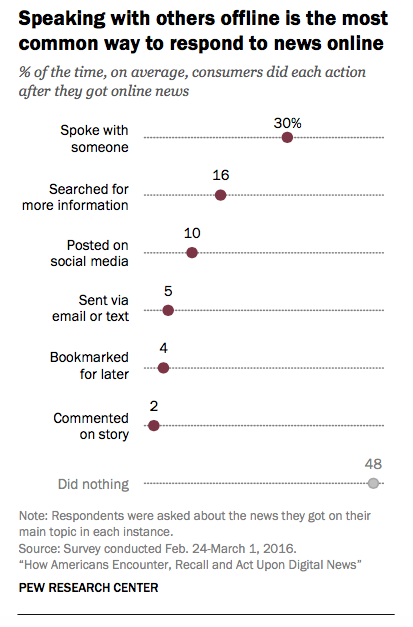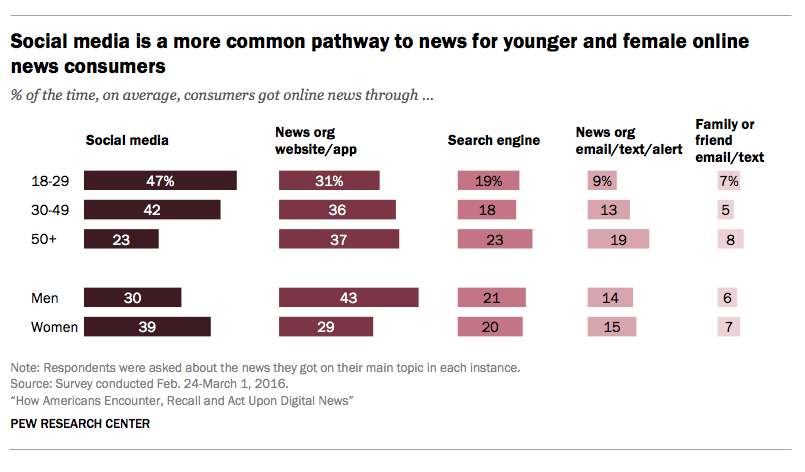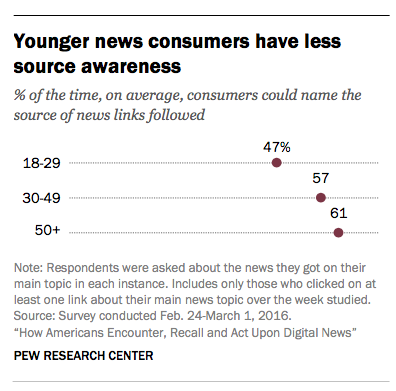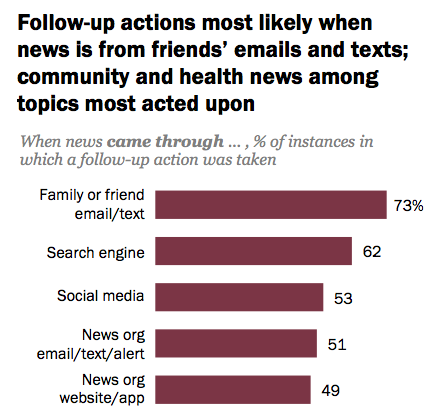
Spend a day clicking back and forth between online news and other stuff and it’s not that surprising that you might not remember what you read where. A study out Thursday from the Pew Research Center looks at how Americans get news online; whether they can recall the names of the news sources that they looked at a little later; and which news experiences inspired further actions like “sharing, searching for more information or talking about it with others.”
The findings may be a little disappointing for news organizations that hope they stand out in a crowded news feed. But one thing the report highlights is that (perhaps not surprisingly) there does not seem to be one “best” or most effective way to distribute news. “The online news experience is a mix of deliberateness and serendipity,” the report’s authors write, noting that people come across news when they’re actively seeking it out (39 percent) and when they’re simply happening upon it while doing other things online (36 percent) in roughly equal measure.
Pew stayed in touch with more than 2,000 U.S. adults who said they got at least some news online over the course of a week and asked them twice a day for a week last February whether they’d gotten news online within the past two hours. If they had, they received follow-up short surveys about the topic of the news, their “pathway” for accessing the news (“a news organization’s website or app, search engines, social networking sites”), whether they remembered the name of the outlet they’d gotten the news from, how they got the news (“Did you seek out this news, happen upon it while doing something else online, or find it while already getting other news?”) and whether they’d followed up on it by taking some action like sharing it.
Among the study’s findings:
— Respondents were equally likely to get news either by going directly to a website (36 percent) or getting through social media (35 percent). Less common pathways: Search engines (20 percent), news organizations’ emails or alerts (15 percent), and a text from a family member or friend (7 percent).
— Respondents could recall the source of a news link 56 percent of the time, on average. (Note they were being asked about news they’d gotten online in the past two hours, so they weren’t having to recall too far back.)
CNN was named at least once over the week by 14% of those who followed links, similar to the 12% who named Fox News and 10% who named Facebook, even though Facebook does not produce the news stories distributed on the site. An additional seven sources were named by at least 3% to 6% of those who clicked on links: The New York Times, The Huffington Post, MSNBC, Yahoo, ESPN, The Washington Post and CBS. No other individual source was named by more than 3% of those who clicked on links.
Pew wasn’t able to check whether respondents were recalling news sources correctly.
— Respondents took some kind of action on a news item 52 percent of the time. Here are those actions:

— Paths to news differ by age…

…as does recall of the specific news source:

(I asked Pew whether younger news consumers are also the most likely ones to erroneously list “Facebook” as the news source. Amy Mitchell, Pew’s director of journalism research, said the complexities of that particular question meant it wasn’t suited for traditional demographic breaks. But a similar percentage of users named “Facebook” as their main source for election news, and Pew plans to study this confusion in the future.)When 18- to 29-year-old online news consumers clicked on news links, they remembered the source about half the time (47%), at least 10 percentage points less than their elders (57% for 30- to 49-year-olds and 61% for those 50 and older). And these younger online news consumers got their news through social media 47% of the time on average, about double the rate of those 50 and older (23%), and about on par with those ages 30 to 49 (42%). Those 50 and older, on the other hand, stand out for their heavier reliance on news organizations’ emails, texts and alerts.
— Whether or not users follow up on news in some way (discussing, sharing, commenting) depends on the source of the news, with a followup action least likely when a story comes via a news organization’s alert or directly through its website:

That might not be too surprising, since news sent out via alert is often breaking news that may not be particularly sharable. (If it’s big enough to be breaking, a lot of other people are probably seeing it too.) Meanwhile, followups on search engine news might have been so high simply because Pew counts “searching for additional information” as a followup action.
“There is no single digital action that stands out for news that comes from a direct connection with a news organization,” the researchers write, “which could suggest an area of challenge for news organizations in terms of how they connect with and engage audiences.”
— On the other hand, respondents were much more likely to remember the source of news when it came directly from a news organization (as an alert, say) than when it came from social media or from an email or text from an acquaintance. “These data reveal a potential challenge for news producers in creating brand awareness among those who land on their content from links sent or posted by others,” the researchers write, adding, “While news directly from news organizations may not encourage a high level of follow-up action, brand awareness of this news is much higher.”
— Users react differently to news depending on its topic; community news is particularly shareable. “Behaviors associated with political news don’t particularly stand out,” Pew notes — suggesting that this study, at least, is not going to shed a ton of light on why exactly certain fake news stories went viral during the election.
The full report is here.